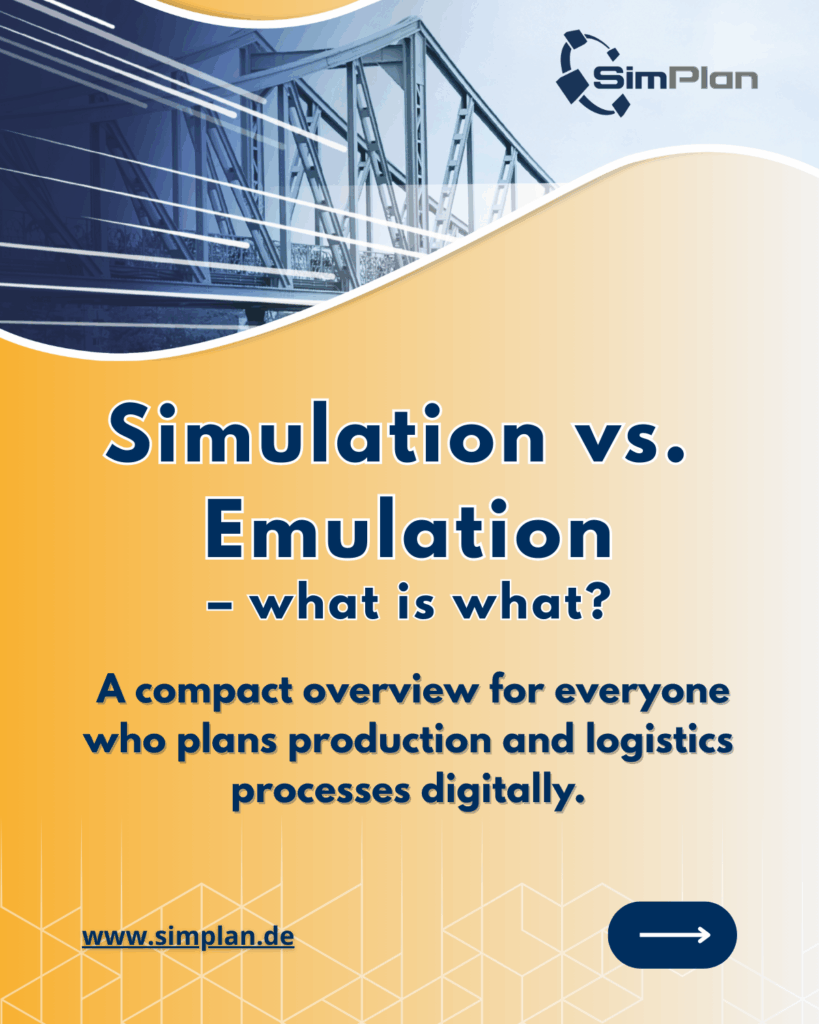What is the difference between simulation and emulation?
The terms ‘simulation’ and ‘emulation’ are appearing more and more frequently in the context of digitalisation, Industry 4.0 and digital twins. They are often used interchangeably or even confused with each other. However, both approaches pursue different goals and complement each other well in many projects.
In this article, we will show you what the differences are, which applications are suitable in each case, and what you should look out for when making your selection.
What is simulation?
Simulations digitally model real systems in order to analyse their behaviour under different conditions.
They make it possible to evaluate processes in advance without interfering with existing processes and are therefore an important tool for planning and decision-making.
Typical objectives:
- Identify bottlenecks
- Compare layouts
- Secure investments
- Test scenarios without risk
Example
A production planner wants to know whether an additional assembly station will improve output. In the simulation, different variants are modelled without interfering with ongoing operations.
What is emulation?
In emulation, a real control system is replaced by a virtual model. This model communicates in real time with control software (e.g. PLC, MES) as if it were a physical system. This allows virtual commissioning to be carried out long before the real technology is set up.
Typical objectives:
- Testing control logic (PLC, MES)
- Virtual commissioning
- Checking interfaces
- Running through error scenarios
Example
A machine manufacturer tests its PLC programming on an emulated model of the system long before the real hardware is set up. This saves time and reduces sources of error.
The most important differences at a glance
| Simulation | Emulation | |
| Purpose | Analysis, planning, decision support | Testing, validation, commissioning |
| Connection | No connection to real control system | Direct real-time connection, e.g. to PLC or MES |
| Time level | Often accelerated (e.g. 1 day = 1 second) | Real time |
| Typical users | Planners, logisticians, decision-makers | Automation specialists, IT, commissioning engineers |
When is what used?
Simulation is typically used in the early planning phase, for example for layout questions, capacity calculations or investment decisions. It helps to analyse different options and make informed decisions.
Emulation is usually used later in the project, once control components have been developed or tested. It supports technical implementation, particularly during virtual commissioning or interface testing.
In many projects, a combination of both approaches makes sense, e.g. when introducing new systems, in retrofit projects or in the context of digital twins.
Practical example:
A new logistics system is first simulated to determine the optimal layout. The model is then emulated to validate the PLC logic – even before the actual technology is set up.
The right application is crucial
Simulation and emulation pursue different goals and are most beneficial when used in combination. Using both methods in a targeted manner creates a solid basis for decision-making and reduces technical risks.
It is important to be clear about the project goal and requirements.
We support you in finding the right approach for your application – manufacturer-neutral and practice-oriented.
Contact us
Would you like to learn more about how simulation can be used in your company? Our team is available for a no-obligation consultation or web meeting.




